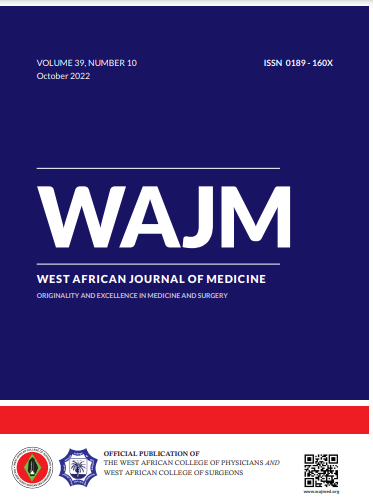ORIGINAL: Bidirectional Screening for Tuberculosis, Diabetes Mellitus and other Comorbid Conditions in a Resource Constrained Setting: A Pilot Study in Lagos, Nigeria
West Afr J Med . 2022 Dec 29;39(12):1305-1311.
Keywords:
Bidirectional screening; Comorbidities; Diabetes mellitus; Tuberculosis.Abstract
Abstract in English, FrenchBackground: The epidemiological transition in developing countries is increasing the burden of non-communicable diseases such as diabetes. We aimed to determine the outcomes of bidirectional screening for TB and diabetes (DM) in resource constrained communities, Lagos, Nigeria.
Methods: A quasi-experimental study without control was conducted from March 1-31st, 2017 as part of the series of activities to mark the World TB Day. Community screening took place at multiple locations in multiple days. Participants were registered and screened for Tuberculosis (TB), Diabetes Mellitus (DM) and other comorbid conditions (viral hepatitis and HIV) during open medical outreaches carried out across six resource constrained communities in Lagos, Nigeria. Relevant data were collected and analyzed. Yield of TB among DM patients and vice-versa was analyzed. Associations between MTB detection among those with DM (versus those with no DM) and among those who were HIV positive (compared with those HIV negative) were determined at p ≤0.05.
Results: Some (24.7%) of the participants were between the ages 25-34 years. Majority were males (65.8%), Christians (55.7%), Married (73.7%), and 37.8% had secondary education. Many (41.0%) of the participants had 3-4 persons per household, and 1-2 persons per room (44.5%). 109(26%) of individuals screened were presumptive and 18(16.5%) of the 109 presumptive were MTB detected. Also, hyperglycemia (Fasting Blood Sugar, FBS >126 mg/dl or random blood sugar, RBS level >200mg/dl) was diagnosed in 31(5%) of the 620 patients screened. Overall, 1(3.2%) of the 32 patients with DM were diagnosed with TB while 1(5.5%) of the 18 patients with MTB detected were diagnosed with DM and no significant difference in TB or DM detection in either of the groups (p=1.000). The overall yield (in all participants) of HIV in this intervention was 1.27%, DM was 5.0% and HBsAg was 2.1%.
Conclusion: This intervention showed that approximately one out of every twenty newly diagnosed TB patients in resource constrained communities had DM as a comorbid condition. This finding underlines the need to strengthen bidirectional screening for TB-DM in order to achieve additional gains in tuberculosis case findings in resource constrained and high TB burden countries.
Keywords: Bidirectional screening; Comorbidities; Diabetes mellitus; Tuberculosis.
V A Adepoju 1 2, O E Adepoju 2, J Inegbeboh 3, O A Adejumo 4, A B Olofinbiyi 2 5, W Imoyera 1


